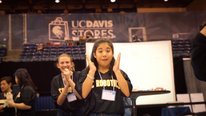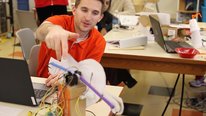NSF Awards: 1433414
There are growing achievement gaps in Science, Technology, Engineering, and Math (STEM) education, and students from non-dominant populations in STEM fields (e.g. non-White populations and women) often find it difficult to envision themselves as capable of “doing” science. Collaborative learning practices (e.g. negotiating power dynamics, establishing group norms, and coming to a consensus) are essential to STEM engagement, and for students’ ability to see themselves as capable of “doing” science and engineering. Learning through hands- on robotic applications has been an effective way to engage diverse groups of students, including non-dominant populations in STEM, in these authentic practices.
Human-centered robotics attends to societal context and human needs and has led to increased motivation in STEM. This STELAR video features an inquiry-based curriculum of robotics experiences centered around a human-centered problem (“How can we create a robot that serves a need in our local context and connects us with remote peers?”). This project aims to engage non-dominant populations in STEM via a socially oriented robotics experience. In this designed robotics unit, students in Indiana and Alaska collaboratively personalize and program robots to both meet a local need and communicate telepresently with remote peers. This robotics project has helped students as individuals and as groups to see themselves and their capacity for STEM differently, and it also informs the way that we as a research community design interventions that cross disciplines, geographic locations, and cultures to create meaningful connections and inspire students to see themselves in STEM.









Andrea Gomoll
Graduate Research Assistant
Welcome to our human-centered robotics video! I'm Andi Gomoll, a graduate research assistant working on this ITEST project. We are excited to hear your reaction to the aspects of our robotics curriculum you saw highlighted in this video, and we look forward to engaging with your questions. A couple of questions from us to get the conversation rolling:
Thank you, and we look forward to learning from you this week!
Andrea Gomoll
Graduate Research Assistant
I would also like to provide a clarification for one caption in our video. The featured Fairbanks student alumna participated in this project while at Tanana Middle School rather than Randy Smith Middle School. We thank her again for her contribution!
Michael Haney
The project uses the social aspects of robotics to involve and interest girls. The design process is quite good specifying the iterative nature of project development and there are good examples from classrooms. I would like to have seen some of the project ideas in final form. Are these available somewhere?
The project notes are very good and interest in outreach is encouraging. What type of data do you have on the students who participated? Assuming that you have found that the impact on girls is positive, have you examined why? Is it the social nature of the development process, the clear focus on solving a real world problem, the multi-disciplinary approach, or what?
Andrea Gomoll
Graduate Research Assistant
Thank you for sharing your thoughts! In response to your first question: We are currently exploring all photos, descriptions, and recorded presentations of the robots created by students across the three years we've been in classrooms and informal learning environments. You can see several of them in the end of this video.We are looking at students' final projects, analyzing their features, and tracing backwards--exploring what groups' journeys to the final products looked like. This work is connected to our interest in collaborative learning and understanding students' work within an engineering design process.
Over the past two semesters, we featured projects created by past students as a resource for students currently engaging with the human-centered robotics (HCR) curriculum. This was part of our ongoing effort to create a hub of HCR resources for students and teachers. This set of resources is housed on the learning management system Canvas and at robotmoose.com, and teachers and students are able to adapt and explore as they navigate the inquiry-based curriculum and design robots to fit local needs and communicate with other students in remote locations. By weaving past and current student examples and voices into these resources, we hoped to help students connect to one another across great distances, see themselves in this STEM work, and be inspired to continue to use technology to address everyday human issues.
Here's a list of several robots created by students:
Thanks again!
Andi
Cindy Hmelo-Silver
Barbara B. Jacobs Chair and Professor
We are still in the process of analyzing data and organizing the project ideas. Some trends that we think we are seeing in the data is that the personalization has been important as well as being able to create something that helps someone in their school.
Vivian Guilfoy
Great project for making useful things and getting students to see what they can accomplish. Like Michael, I would like to see the final iterations of the robots and understand better how they "helped" teachers and folks in the health professions. Are the robots still "in circulation" now and do they continue to be used? Look forward to learning more through your data analyses.
Selma Sabanovic
Associate Professor
Thank you very much for your comments! Some of the final versions of the robots, as far as the students took them, are in the last few minutes of the video (the nurse robot, robot for teachers, etc.). These are all still build largely as prototypes, not as fully functioning products, so we haven't really expected them to be in continued use in the classroom. As we have gotten better at developing and supporting the students' activities in the curriculum, and as the teachers have gained more experience with it, the students seem to be getting further in terms of developing robots that others can use. For example, more recent incarnations of the curriculum have seen other students and parents test out the robots, or students have been able to get feedback from potential users for thinking through what they would need in future prototype iterations. Thank you again!
Thomas Kalil
Entrepreneur in Residence
Great video and project! What student learning outcomes are you planning to assess? Also, what do you think the students will take away from the experience with respect to human-centered design and "design thinking?"
Andrea Gomoll
Graduate Research Assistant
Thank you for your question! Our human-centered robotics curriculum has been used in a variety of disciplinary contexts (engineering courses, STEM electives, advisory periods, and afterschool spaces). With this in mind, we've focused our assessments on students' understanding and application of the engineering design cycle. Our curriculum asks students to solve a problem by asking questions, brainstorming, collecting information, developing and testing solutions, and improving their designed solutions. Facilitators and instructors stress that all parts of this design cycle are interconnected and iterative.
Exploring students' design thinking, we've looked at scenario-based pre and post interviews and formative design presentations given throughout the robotics unit. Pre and post interviews we used in this past school year asked students to design a robot for a client. The interviewer played the role of the client and the student responding to various questions about how they would design, test, and iterate in the process of building a robot to fit the client's needs. We've also conducted small group observations in every class period to look at how and when students were engaging in each phase of the design cycle outlined above. These observations made use of an online application that could be used in real time to code for students' work within the design cycle.
Anna Suarez
Principal
Very interesting video and project. Did the project adapt an existing robotics curriculum or was one created by the team? How long are students engaged in the program/project?
Is the curriculum primarily delivered in an informal or formal setting?
Cindy Hmelo-Silver
Barbara B. Jacobs Chair and Professor
Thanks for watching the video-- We created the project as a collaboration between experts in Human-centered Robotics and Learning Sciences. We have used the curriculum materials is both formal and informal settings. In general, the curriculum is designed for 4-6 weeks when part of everyday science class. When used in an after-school setting, we have used it once a week over the whole semester. We want to be sure that the participants have time to be able to build a working prototype and test it.
Further posting is closed as the showcase has ended.